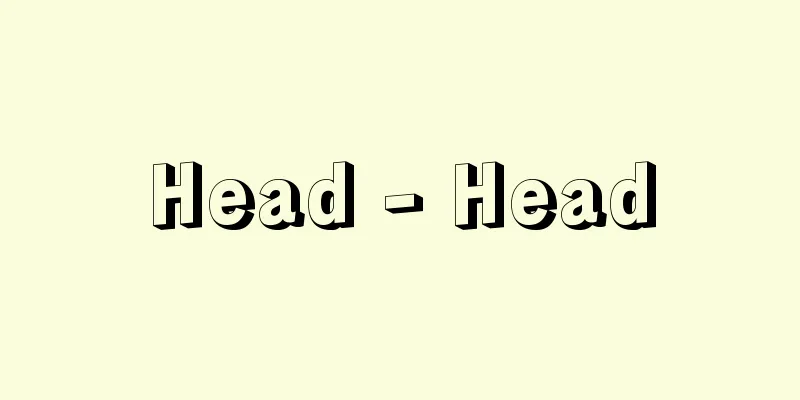Head - Head

|
The central nervous system, which is one of the major characteristics of vertebrates, is located on the back of the body and expands forward to become the brain. To accommodate this, a bone box, or skull, has developed at the front end of the spine. This part is called the head. Generally, when an animal moves in a certain direction, the head is always at the front end, where the brain has developed and the sense organs such as the eyes, ears, and nose are gathered, and the mouth is also open here. In other words, it is thought that animals' movement of the entire body developed in connection with the intake of nutritious organic matter as food. First, the sensory organs receive information from the environment, and then the brain sends commands to the motor organs, which help to express behavior appropriate to the purpose. The formation of a part of the body in this way is called cephalization. When vertebrates, along with protochordates, are included in the group of chordates that are thought to be their ancestors, they are sometimes called cephalic animals to distinguish them from the group of chordates that are thought to be their ancestors, because the presence of the head is particularly noticeable. However, in fish and amphibians, which do not have a developed neck, it is not as easy to distinguish them as in birds and mammals. In the former case, if they had a neck and the head was able to move freely, it would be difficult for them to live underwater due to water pressure, and this is clear in the case of mammals such as whales. Invertebrates with a remarkable degree of cephalogenesis are arthropods, such as terrestrial insects and aquatic crustaceans, whose bodies are composed of three parts: head, thorax, and abdomen. Among mollusks, cephalogenesis is seen in gastropods of snail shells (snails, sea hares) and cephalopods (squids, octopuses), but bivalves (clams) have no heads. In annelids such as earthworms and leeches, the two anterior segments of the body are slightly deformed to form a head that contains the brain, but in polychaetes (lugworms), the development of sensory organs such as antennae and eyes is conspicuous. In flatworms, the brain and eyes are found in the head, but the mouth opens separately from the head into the abdomen. In general, cephalicity is observed in bilaterian animals that actively move, but not in actinomorphs such as sea urchins and starfish. In some cases, the term "head" is used because it resembles the original head in shape or because it becomes the anterior end when moving, such as the main body part of sea squirt larvae and tadpole ascidians, or the nucleus of sperm. The bones of the head, or skull, are a general term for the cranium and visceral bones, but in higher vertebrates, all of the skeleton derived from the visceral bones, except for the laryngeal cartilage, participate in the formation of the skull, so the terms skull and cranium are used synonymously. The skeleton derived from the visceral bones mainly forms the face, so it is called the facial cranium (visceral cranium), and the part that contains the brain and sensory organs is called the neurocranium (neurocranium), but the latter is also called the skull in a narrow sense. The initial formation of the skull is a long, thin plate-like cartilage that forms at the anterior end of the notochord and below the brain during embryonic development, and hard bones formed directly from this ossification and connective tissue are added. The cartilage cranium is primitive and is found in jawless fish (lampreys), elasmobranchs (sharks, rays), holocephali (chimaer fish), and lungfish (protopterus). Skulls are also found in squids and octopuses, but they remain cartilaginous throughout their lives and are of simple structure. The number of bones that make up the skull tends to decrease as vertebrates become more advanced. Fish have 100-180 bones, while amphibians and reptiles have 50-90, and mammals have almost half that number, with apes and humans having no more than 30. Some fish can also be clearly distinguished between males and females by the shape of their heads. Male kandai have a protruding hump-like forehead, and were once called humphead wrasse and were thought to be a separate species from females. Male dolphinfish also change head shape from females as they grow, with their foreheads becoming more prominent. [Seiichiro Kawashima] Human HeadIn the case of the human body, the part above the neck is called the head, and it is roughly divided into the head and the face. The head excluding the face includes six parts: the frontal region (from above the eyebrows to the hairline, commonly known as the forehead), parietal region (from the frontal region to the top of the head), temporal region (above the auricle), occipital region (above the line drawn from the mastoid process of the temporal bone to the most prominent part of the occipital bone), mastoid region (below and behind the auricle), and auricle. The mastoid region and auricle are collectively called the subtemporal region, and are sometimes included in the temporal region. There is no hair on the frontal region, auricle, or mastoid region. The skeleton that forms the shape of the head is the skull, which is also called the braincase because it contains the brain, but the skull is made up of bones with the same names as the sections of the head. These include the frontal, parietal, temporal, and occipital bones, as well as the sphenoid and ethmoid bones. The sphenoid and ethmoid bones are located in the center of the base of the skull, so the frontal, parietal, temporal, and occipital bones are the main components that form the outer shape of the head. The skin (scalp) is thick and hard, and thick hair grows on it. There is little subcutaneous tissue beneath the scalp, with only a thin layer of muscle and a membrane of connective tissue (the galea aponeurosis), which is immediately in contact with the skull, which is covered by the periosteum, so when a hard object hits the head, the external force acts directly on the skull, making it susceptible to damage. When you place your fingers on the scalp of a newborn baby, there are areas in front of and behind the top of the head where you can feel the pulsation of the cerebral arteries. At birth, the skull of a newborn baby has not yet ossified and the bones have not yet fused together, which is why the pulsation can be felt. The gaps where there is no fusion are filled with connective tissue, but at the top of the head, there are relatively wide bone gaps where the sagittal suture and coronal suture intersect, and where the sagittal suture and lambdoid suture intersect; the former is called the anterior fontanel, and the latter the posterior fontanel. As the baby ages and the skull develops, the fontanel disappears and is gradually replaced by bony sutures. The posterior fontanel closes at about 2 months after birth, and the anterior fontanel closes at 14 to 22 months. Head shape varies greatly from person to person and is influenced by various factors such as gender, age, race, and ethnicity, making it difficult to classify head shapes. However, because comparison of head shapes is also important from a genetic standpoint, this study uses head diameter indexes, which are measured according to a set method. Typical indexes include the length-width index (maximum head diameter width ÷ maximum head diameter length x 100) and the length-height index (maximum head diameter height ÷ maximum head diameter length x 100). The length-width index is an index seen from above the head, and the length-height index is an index seen from the side. With the length-width index, the longer the head shape is from front to back, the smaller the index, and the wider the head shape is, the larger the index. There are classifications of head diameter index: hypercephalic (less than 70), long head (70-74.9), medium head (75-79.9), brachycephalic (80-84.9), and brachycephalic (over 85). In terms of head height, there are classifications of short head (less than 70), normal head (70-74.9), and high head (over 75). When looking at Japanese people based on this head diameter index, there is considerable variation, but generally, people on the Japan Sea coast and in northern Japan tend to be long-headed and short-headed, people in western Japan tend to be short-headed and high-headed, and people in the Kanto region tend to be medium-headed and high-headed. In terms of race, people with dark brown skin (such as blacks) are long-headed, people with yellow-brown or light-colored skin (Caucasians, Ainu) are medium-headed, and people with yellow-brown to tan skin (Orientals, Arabs) are short-headed. Japanese people are generally said to be somewhere between short-headed and medium-headed. [Kazuyo Shimai] [References] |©Shogakukan "> Names of head parts ©Yoshitaka Morikami "> Animal Head Source: Shogakukan Encyclopedia Nipponica About Encyclopedia Nipponica Information | Legend |
|
脊椎(せきつい)動物の大きな特徴の一つとされる中枢神経系は、体の背側にあって前方が拡大して脳となっているが、これを入れるために脊椎の前端に骨の箱、つまり頭蓋(とうがい)が発達している。この部分をとくに頭という。一般に動物が一定の方向に移動するとき、つねにその前端となるのが頭であり、ここに脳が発達して目、耳、鼻などの感覚器が集まっており、口もこの部分に開いている。すなわち、動物が体全体を移動させるのは、栄養となる有機物を食物として摂取することと関連して発達したと考えられる。まず感覚器で環境からの情報を受け取り、脳を通して運動器官に命令し、目的に適した行動を発現するのに役だつわけである。体の一部がこのような形になることを頭化という。原索動物とともに脊椎動物を、その祖先とみられる脊索動物の一群に含める場合に有頭類とよんで区別することがあるのは、頭の存在がとくに目だつためである。しかし、頸(くび)の発達していない魚類や両生類では、鳥類や哺乳(ほにゅう)類ほどに区別が容易でない。前者の場合、頸があって頭が自由に動いては、水圧の関係から、水中生活がやりにくいためであり、哺乳類のクジラをみても明らかである。 無脊椎動物で頭化の著しいものは、陸上の昆虫類、水界の甲殻類に代表される節足動物で、体はいずれも頭、胸、腹の3部からなる。軟体動物では巻き貝の腹足類(マイマイ、アメフラシ)や頭足類(イカ、タコ)に頭化がみられるが、二枚貝類(アサリ)には頭がない。環形動物のミミズやヒルでは、体の前端の2節が多少変形して頭をつくり、内部に脳を含むが、多毛類(ゴカイ)では触糸や目などの感覚器官の発達が目だつ。扁形(へんけい)動物のウズムシ類では頭部に脳と眼点はあるが、口は頭部と独立して腹部に開く。 一般に、積極的に移動する左右相称動物には頭化がみられるが、ウニやヒトデのような放射相称動物では頭化がない。なお、このような本来の頭と形態が類似していたり、移動する際に前端部となるところから頭とよばれる場合があり、ホヤの幼生やオタマボヤにみられる体主部、または精子の核部分などがその例である。 頭の骨、すなわち頭骨とは頭蓋と内臓骨との総称であるが、高等脊椎動物では内臓骨に由来する骨格が喉頭軟骨(こうとうなんこつ)以外はすべて頭蓋の形成にあずかるので、頭骨と頭蓋骨は同義語として用いられる。内臓骨由来の骨格はおもに顔面をつくるので顔面頭蓋(内臓頭蓋)といい、脳や感覚器を包む部分を脳頭蓋(神経頭蓋)とよんで区別するが、後者は狭い意味で頭蓋骨ともいう。頭蓋の形成初期は、胚(はい)発生の過程で脊索の前端と脳の下側に生ずる細長い板状の軟骨で、これの骨化と結合組織から直接形成された硬骨が加わる。軟骨頭蓋は原始的で、無顎(むがく)類(ヤツメウナギ)、板鰓(ばんさい)類(サメ、エイ)、全頭類(ギンザメ)、肺魚類(プロトプテルス)にみられる。頭蓋はイカやタコの類にも認められるが、一生軟骨のままで、構造も簡単である。なお、頭骨を構成する骨の数は、脊椎動物が高等になるほど減少してくる傾向がある。魚類では100~180個もあるが、両生類や爬虫(はちゅう)類では50~90個となり、哺乳類になるとほぼその半数まで減少し、類人猿やヒトでは30個以内にとどまる。また、魚類では頭の形によって雌雄の別がはっきりするものもある。カンダイの雄は額部がこぶのように突出しており、かつてはコブダイとよばれて雌とは別種と考えられていたほどである。シイラの雄も成長につれて雌とは頭の形が変わり、前額部が隆起してくる。 [川島誠一郎] ヒトの頭人体の場合、形態的には頸部(けいぶ)から上方の部分を頭といい、頭の部分(頭部)と顔面(顔部)とに大別される。顔面を除く頭の部分とは、前頭部(眉(まゆ)の上から頭髪の生え際あたりまでで、いわゆる額(ひたい))、頭頂部(前頭部に続き頭の頂上まで)、側頭部(耳介の上方)、後頭部(側頭骨の乳様突起から後頭骨の最突出部まで引いた線より上方)、乳突部(耳介の後下部)、耳介部の6部を含めた範囲をいう。乳突部と耳介部は、両者を総称して側頭下部とよび、側頭部に含まれることもある。前頭部、耳介部、乳突部には毛髪は生えていない。頭の形態をつくっている骨格は頭蓋骨(とうがいこつ)で、脳髄(のうずい)を収容しているので脳頭蓋ともいうが、頭の区分名と同名の骨が頭蓋を構成している。すなわち前頭骨、頭頂骨、側頭骨、後頭骨、さらに蝶形骨(ちょうけいこつ)、篩骨(しこつ)が加わる。蝶形骨、篩骨は頭蓋底の真ん中に位置しているから、頭の外形をつくっているのはおもに前頭骨、頭頂骨、側頭骨、後頭骨である。皮膚(頭皮)は厚くて硬く、太い毛髪が生えている。頭皮下には皮下組織が少なく、薄い筋層や結合組織の膜(帽状腱膜(けんまく))があるのみで、すぐに骨膜に覆われた頭蓋骨に接しているため堅い物が頭部にぶつかると、直接、頭蓋骨に外力が及んで損傷をおこしやすい。 新生児の頭の頂点の前後で、指を頭皮にあてると拍動を感じる部分があるが、これは脳の動脈の拍動が伝わるためである。新生児の頭蓋骨は出生時にはまだ骨化しないで、頭蓋骨相互の癒合を生じていないために、拍動がわかるわけである。癒合を生じていない間隙(かんげき)には、結合組織が充填(じゅうてん)されているが、頭頂部には矢状縫合と冠状縫合とが交わる部位、および矢状縫合とラムダ(状)縫合とが交わる部位には、比較的広い骨間隙ができており、前者を大泉門(だいせんもん)、後者を小泉門とよぶ。泉門は年齢の増加に伴い、頭蓋骨の発育とともに消失し、しだいに骨縫合に変わる。小泉門は生後約2か月、大泉門は14~22か月で閉鎖する。 頭の形は個人差が著しく、また、性別差、年齢差、人種差、民族差といったさまざまな要素が関係しているため、頭の形の分類はむずかしいとされている。しかし、遺伝学的にも頭型の比較は重要な意味をもっているため、この研究には一定の方法に従って計測する頭径示数が用いられる。代表的な示数表示法として長幅示数(頭径最大幅÷頭径最大長×100)や、長高示数(頭径最大高÷頭径最大長×100)がある。長幅示数は頭の上方から見た示数、長高示数は頭を側面から見た示数である。長幅示数では、頭の形が前後に長いほど示数が小さく、幅が広いほど示数は大である。過長頭(示数70未満)、長頭(70~74.9)、中頭(75~79.9)、短頭(80~84.9)、過短頭(85以上)の分類があり、また高さでは低頭(70未満)、正頭(70~74.9)、高頭(75以上)の分類がある。この頭径示数を基準にして日本人をみた場合、かなり変化があるが、一般的には日本海側や北日本の地域では長頭、低頭傾向で、西日本地域では短頭、高頭傾向、関東地域では中頭、高頭の傾向があるという。人種的にも、黒褐色系の皮膚をもつ人種(黒人など)は長頭型で、黄褐色あるいは明淡色系皮膚をもつ人種(白人、アイヌ)は中頭型、黄褐色から土色皮膚の人種(東洋人、アラブ人)は短頭型である。日本人は全般的には短頭と中頭との中間といわれる。 [嶋井和世] [参照項目] |©Shogakukan"> 頭の各部名称 ©森上義孝"> 動物の頭 出典 小学館 日本大百科全書(ニッポニカ)日本大百科全書(ニッポニカ)について 情報 | 凡例 |
<<: Athamās - Atamasu (English spelling)
>>: Atā bek (English spelling)
Recommend
Aquileia (English spelling)
An ancient Roman city located on the north coast o...
Wet Rendering
…These animal fats are produced by the rendering ...
Unnuke - Unnuke
A large perennial grass of the grass family (illus...
Mandala of Both Worlds
The combined name of the Vajrayana Mandala and the...
Ujikoiri - parishioner
To become a parishioner of the village's guard...
Setara (English spelling) Eemil Nestor Setälä
1864‐1935 Finnish linguist. Professor of Finnish l...
Mahāmoggallāna (English spelling)
…In the Heart Sutra, he appears as the Buddha’s p...
Boat race
…Both of them boast high performance, using ultra...
Back Ginza Trail - Back Ginza Trail
...Birds such as the rock lark, the ptarmigan, an...
Phycitinae
...(8) The Pyralinae subfamily has more than 40 k...
Mr. Kasa - Kasa
...An ancient Kibi clan. According to the legends...
Abū āmid al-Ghazālī
A Sunni Muslim theologian and religious thinker, ...
Hebros
…a river that flows through the three countries o...
Rochus
A Christian saint who lived from about 1295 to abo...
Radiation monitor - Hoshasen monitor
Radiation monitoring is not only used to ensure th...









